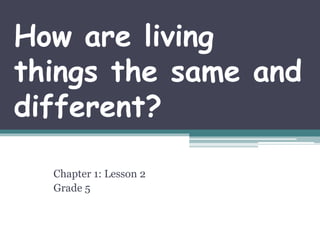How are living things similar and different
- 1. How are living things the same and different? Chapter 1: Lesson 2 Grade 5
- 3. What is classification? It is the grouping of living organisms according to similar characteristics.
- 5. The modern classification system was developed by: Linnaeus
- 6. Classify the handed objects into 2 groups Objects you can use Objects you cannot use
- 7. Classify the objects into smaller subgroups Objects you can use … at home … in the kitchen … made of plastic … holds liquids
- 8. Where do you live? Country City Area / District Street Building Floor Apartment
- 9. The modern classification method consists of 7 levels: Kingdom Phylum Class Order Family Genus Species
- 10. Helpful way to remember the 7 levels Kids Playing Squashed. Catch On Freeway Get
- 11. • Which is the biggest group? • Which is the smallest group?
- 12. Latin or Greek name animals - Kingdom - Animalia chordates - Phylum - Chordata mammals - Class - Mammalia primates - Order - Primates great apes - Family - Hominidae Man/humans - Genus - Homo wise - Species - sapiens Classification of humans:
- 13. The Animal kingdom is divided into 2 groups. Vertebrates Invertebrates Animals with a backbone Animals without a backbone
- 14. HOW ARE DIFFERENT ANIMALS GROUPED ? Animals vertebrates Invertebrate s
- 15. VERTEBRATES
- 16. ANIMALS WHICH HAVE VERTEBRAL COLUMN (BACK BONE)
- 17. CAMEL
- 18. CROCODILE
- 19. DUCK
- 20. ELEPHANT
- 21. GIRAFFE
- 22. FROG
- 23. LION
- 24. RAT
- 25. SNAKE
- 26. TURTLE
- 27. INVERTEBRATES
- 28. ANIMALS WHICH DON’T HAVE VERTEBRAL COLUMN (BACK BONE)
- 29. BEE
- 30. ANT
- 31. COCKROACH
- 32. HOUSE FLY
- 33. PRAWN
- 34. JELLYFISH
- 35. CRAB
- 36. BUTTERFLY
- 37. OCTOPUS
- 38. SNAIL
- 39. WORM
- 40. STARFISH
- 42. Mammal s
- 43. They give birth and feed their babies milk
- 44. Have lungs for breathing
- 45. Have fur
- 48. Mammals Hair or fur (to keep warm) Ex. Polar bear Lungs (to breathe in oxygen) Ex. Whales Give birth to babies. (Parents take care of the baby, until it can live alone) Feed their babies milk.
- 49. Birds
- 52. Lay eggs
- 53. duck
- 54. ostrich
- 55. PARROT
- 56. TURKEY
- 57. PEACOCK
- 58. OWL
- 59. Penguin
- 60. Birds Feathers Wings (to help them fly) Penguins have wings but cannot fly. Two legs Lungs (to breathe oxygen from the air) Lay eggs
- 61. AMPHIBIANS
- 63. LAY EGGS IN WATER
- 65. SALAMANDER
- 67. NEWT
- 70. Fish
- 71. Have scales / scaly skin
- 72. Breath by gills
- 73. Lay eggs
- 74. Lay eggs
- 75. Live in water
- 76. Tuna fish
- 77. Salomon fish
- 80. Reptiles
- 81. Have scales and dry skin
- 82. Crocodile Scales
- 83. Lay eggs
- 87. Reptiles Dry skin Skin is covered with scales (thin flat plates to protect the animal) Lungs (reptiles that spend lots of time in water go to the surface to breathe oxygen) Some lay eggs, some give birth.
- 88. Let’s solve some puzzles
- 89. I LIVE IN THE SEA ALL MY LIFE BUT I DON’T HAVE GILLS TO BREATHE. I HAVE LUNGS SO I MUST COME TO THE SURFACE OF THE SEA TO BREATHE. I FEED MY YOUNG MILK. WHO AM I ? WHICH GROUP DO I BELONG TO? Whales Mammal
- 91. I LIVE IN THE SEA FOR HALF MY LIFE AND CAN DIVE HALF A KILOMETRE UNDER THE SEA, BUT I DO NOT HAVE GILLS TO BREATHE. I HAVE LUNGS SO I MUST COME TO THE SURFACE TO BREATHE. I LAY EGGS AND HAVE FEATHERS. WHO AM I ? WHICH GROUP DO I BELONG TO? Penguins Birds
- 92. I HAVE WINGS, I CAN FLY VERY FAST TO CATCH INSECTS BUT I HAVE FUR. MY YOUNG ARE BORN LIVE AND I FEED THEM MILK. WHO AM I ? WHICH GROUP DO I BELONG TO? Bats Mammal
- 93. The Animal kingdom is divided into 2 groups. Vertebrates Invertebrates Animals with a backbone Animals without a backbone
- 94. Invertebrates include: Snails Mollusks (soft bodies) (include many shelled animals) Echinoderms (Hedgehog skin) Clams Sea urchin Star fish
- 95. Invertebrates also include: Spiders Arthropods (Jointed legs) (Largest invertebrate phylum) Crabs Insects Lobster
- 96. Plant kingdom can be classified as: Vascular plants Non-Vascular plants
- 97. Vascular plants Have tubes or vessels Transports food Transports water
- 98. Vessels
- 100. Cactus.
- 101. Orchids
- 102. Non- Vascular plants (without vessels) Non vascular plants grow close to the ground to absorb water
- 103. Non-vascular plants - They don’t have real roots. (They just look like roots) - They have parts that look like stems but they are not real stems. - They have leaf like structures, but they are not real leaves. The leaves, stems and roots are not real BECAUSE: They do not have VESSELS.
- 104. When non-vascular plants are dry they look like: Dry sponge Non-vascular plants are absorb water like: sponges
